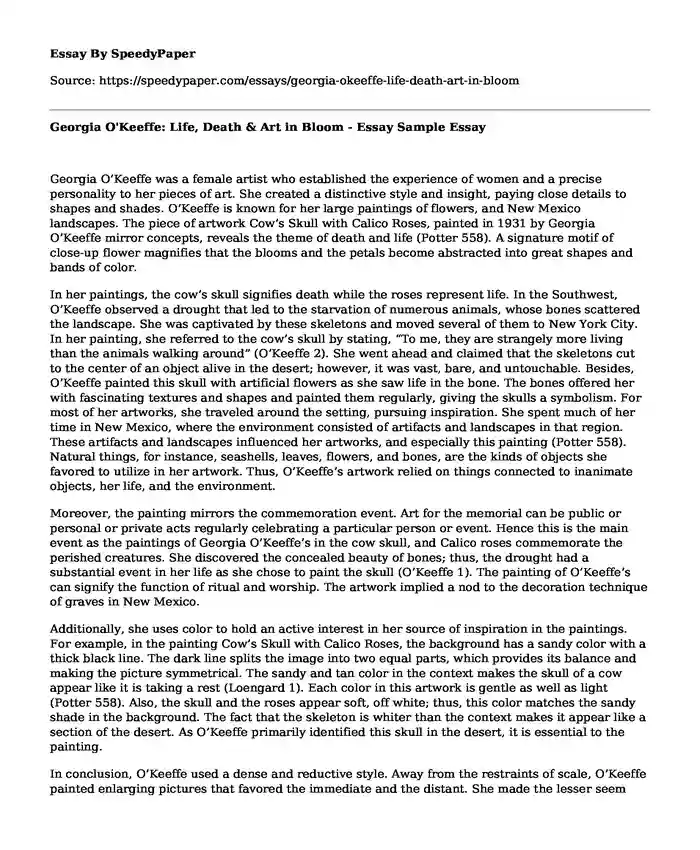Georgia O’Keeffe was a female artist who established the experience of women and a precise personality to her pieces of art. She created a distinctive style and insight, paying close details to shapes and shades. O’Keeffe is known for her large paintings of flowers, and New Mexico landscapes. The piece of artwork Cow’s Skull with Calico Roses, painted in 1931 by Georgia O’Keeffe mirror concepts, reveals the theme of death and life (Potter 558). A signature motif of close-up flower magnifies that the blooms and the petals become abstracted into great shapes and bands of color.
In her paintings, the cow’s skull signifies death while the roses represent life. In the Southwest, O’Keeffe observed a drought that led to the starvation of numerous animals, whose bones scattered the landscape. She was captivated by these skeletons and moved several of them to New York City. In her painting, she referred to the cow’s skull by stating, “To me, they are strangely more living than the animals walking around” (O’Keeffe 2). She went ahead and claimed that the skeletons cut to the center of an object alive in the desert; however, it was vast, bare, and untouchable. Besides, O’Keeffe painted this skull with artificial flowers as she saw life in the bone. The bones offered her with fascinating textures and shapes and painted them regularly, giving the skulls a symbolism. For most of her artworks, she traveled around the setting, pursuing inspiration. She spent much of her time in New Mexico, where the environment consisted of artifacts and landscapes in that region. These artifacts and landscapes influenced her artworks, and especially this painting (Potter 558). Natural things, for instance, seashells, leaves, flowers, and bones, are the kinds of objects she favored to utilize in her artwork. Thus, O’Keeffe’s artwork relied on things connected to inanimate objects, her life, and the environment.
Moreover, the painting mirrors the commemoration event. Art for the memorial can be public or personal or private acts regularly celebrating a particular person or event. Hence this is the main event as the paintings of Georgia O’Keeffe’s in the cow skull, and Calico roses commemorate the perished creatures. She discovered the concealed beauty of bones; thus, the drought had a substantial event in her life as she chose to paint the skull (O’Keeffe 1). The painting of O’Keeffe’s can signify the function of ritual and worship. The artwork implied a nod to the decoration technique of graves in New Mexico.
Additionally, she uses color to hold an active interest in her source of inspiration in the paintings. For example, in the painting Cow’s Skull with Calico Roses, the background has a sandy color with a thick black line. The dark line splits the image into two equal parts, which provides its balance and making the picture symmetrical. The sandy and tan color in the context makes the skull of a cow appear like it is taking a rest (Loengard 1). Each color in this artwork is gentle as well as light (Potter 558). Also, the skull and the roses appear soft, off white; thus, this color matches the sandy shade in the background. The fact that the skeleton is whiter than the context makes it appear like a section of the desert. As O’Keeffe primarily identified this skull in the desert, it is essential to the painting.
In conclusion, O’Keeffe used a dense and reductive style. Away from the restraints of scale, O’Keeffe painted enlarging pictures that favored the immediate and the distant. She made the lesser seem huge as she concentrated on a single isolated item such as bone, stone, flower, and mountain. O’Keeffe remained factual to her distinct artistic vision and established a highly individual painting style, which created the modern European formal language abstraction. She comprehended that emptiness could indicate fullness hence applying this belief in panoramic paintings of landscape and lone objects positioned in pictorial space.
Works Cited
Loengard, John. Image and Imagination: Georgia O’Keeffe. Chronicle Books, 2007, p.1.
O’Keeffe Georgia. “About myself” in Georgia O’Keeffe: Exhibition of oils and pastels. New York: An American Place; 1939, pp.1-2
Potter, Polyxeni. “Georgia O’Keeffe (1887–1986). Cow’s Skull with Calico Roses (1932).” Emerging Infectious Diseases, 2004, p. 558.
Cite this page
Georgia O'Keeffe: Life, Death & Art in Bloom - Essay Sample. (2023, Oct 15). Retrieved from https://speedypaper.com/essays/georgia-okeeffe-life-death-art-in-bloom
Request Removal
If you are the original author of this essay and no longer wish to have it published on the SpeedyPaper website, please click below to request its removal:
- Free Essay with Critical Evaluation of Luxury Brand Stores: Saint Laurent and Balmain
- Essay Example on Bill Cunningham
- Essay Example Based on the Susan Glaspell's Play Trifles
- Plays Analysis in the Free Essay Example
- Free Essay. Visual Analysis of Paul Cezanne's Still Life with Apples 1895-98
- Introduction to Film "Lord of the Rings: Fellowship of the Ring" - Free Essay
- Free Paper Sample on Saint' Apollinare Nuovo
Popular categories





